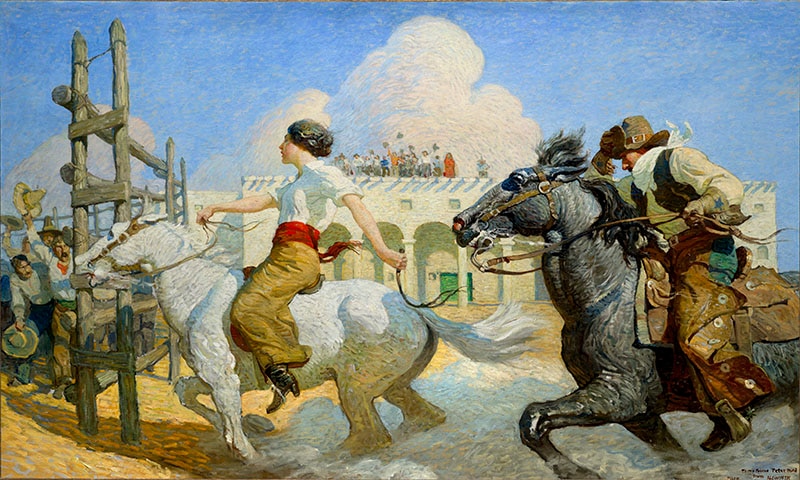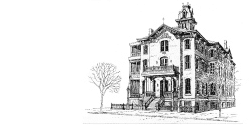Illustrating the West
N.C. Wyeth, The Lady Wins, 1915.
Background Information
Early on, but particularly as the “Old” West became more settled, or less “old” and “wild,” stories in books and magazines (and eventually, movies) continued to feed the myth of the Wild West. Artists, many of whom travelled to and familiarized themselves with the frontier, brought these stories to life through illustrations. While many were destined to become black and white prints or lithographs, most began as expressive, colorful paintings that whetted the desire of individuals in urban, industrial cities to experience what life might be like on the open prairie, rustling livestock, holding down the fort, having a shootout with bandits, and encountering Native Americans.
This painting by N.C. Wyeth was originally published in black in white in Collier’s Weekly (vol. 56, no. 14, December 1915) to illustrate a short story by V. Roe, entitled “What Happened at El Rancho Verde.” Here Wyeth illustrates the story of the relationship between a rich, female ranch owner, and the lovestruck sheriff. In the story, the lady has refused the proposal of the sheriff on multiple occasions. Eventually, she shelters a boy that has stolen a horse, and for whom the sheriff is searching. The lady challenges the sheriff to a horse race that will determine the future for the boy—as her ward, or a prison sentence. The race was neck-and-neck, but eventually the lady pulls ahead of the sheriff. After winning the race and securing the boy’s safety, she finally accepts the sheriff’s hand in marriage.
Look Closer

It is key that illustrators capture the essence of the story. Look at this picture and think about which part of the story Wyeth is depicting and how. Notice the woman on her horse pulling forward on the left. What color is her horse?
Notice the sheriff racing in from the right. What color is his horse?
Notice the cheering crowd on the left,
as well as the spectators on the roof.
Compare the woman’s facial expression and body language
with the sheriff’s.
N.C. Wyeth, The Lady Wins, 1915.
It is key that illustrators capture the essence of the story. Look at this picture closely and think about which part of the story Wyeth is depicting and how. Notice the woman on her horse pulling forward on the left. What color is her horse1? Notice the sheriff racing in from the right. What color is his horse2? Notice the cheering crowd on the left3, as well as the spectators on the roof4. Compare the woman’s facial expression and body language5 with the sheriff’s6.
Discussion Questions
- This picture was originally published in black and white, alongside the story. How might color, size, and relationship to text change your interpretation of the picture?
- Illustrators make many choices as they tell the story visually. How has the artist done so here? What part of the story do you think this is?
- What is the tone of the painting, or how has he captured the feeling of the story?
Activity
Illustrators, like N.C. Wyeth, make choices about how they will envision the story they illustrate. They decide whether their illustration will be abstract or realistic; detailed or simplified; colorful or monochromatic. Whatever the style, the artist must make sure to convey the key points of the story they are illustrating including action, setting, characters, and tone. These artists even have to consider the relationship between the words and the images, and help to keep the story alive in the minds of the readers. Create an illustration based on a story you’re reading in class, or use one of our suggestions below. Highlight the part of the story you plan to illustrate, make some preliminary sketches, and create an artwork that incorporates your final illustration and the line(s) in the story that you are illustrating.
Materials:
Story (either one of your own, or try one of these: Henry Wadsworth Longfellow’s The Song of Hiawatha ; Ute Creation Story; Willa Cather’s My Antonia; or Zane Gray’s Riders of the Purple Sage)
Paper for preliminary sketches
Highlighter
Pencils
Large paper for final illustration
Colored pencils/crayons/markers/watercolors
Picture books to serve as examples of illustration
Grade levels: P-12 CO Standards
Visual Arts (2020)
Preschool: 1.1 ; 2.1 ; 3.1 ; 4.1
Kindergarten: 1.1. ; 2.1 ; 3.1 ; 4.1
1st Grade: 1.1 ; 2.1 ; 3.1 ; 4.1
2nd Grade: 1.1 ; 2.1 ; 3.1 ; 4.1
3rd Grade: 1.1 ; 2.1 ; 3.1 ; 4.1
4th Grade: 1.1-2 ; 2.1-2 ; 3.1-2
5th Grade: 1.1-2 ; 2.1-2 ; 3.1-2
6th Grade: 1.1-3 ; 2.1-2 ; 3.1-3 ; 4.2
7th Grade: 1.1-3 ; 2.1-2 ; 3.1-3 ; 4.1-2
8th Grade: 1.1-3 ; 2.1-2 ; 3.1-3 ; 4.1-2
High School: 1.1-3 ; 2.1-3 ; 3.1-3 ; 4.1-3
Reading, Writing and Communicating (2020)
Preschool: 1.1-2 ; 2.1 ; 3.1 ; 4.1
Kindergarten: 1.1-2 ; 2.1,3 ; 3.1
1st Grade: 1.1-2 ; 2.1,3
2nd Grade: 1.1-2 ; 2.1,3
3rd Grade: 1.1-2 ; 2.1,3
4th Grade: 1.1-2 ; 2.1,3
5th Grade: 1.1-2 ; 2.1,3
6th Grade: 1.1-2 ; 2.1,3
7th Grade: 1.1-2 ; 2.1,3
8th Grade: 1.1 ; 2.1-3
9th/10th Grade: 1.1 ; 2.1-3
11th/12th Grade: 1.1 ; 2.1-3
Resources
Downloads


